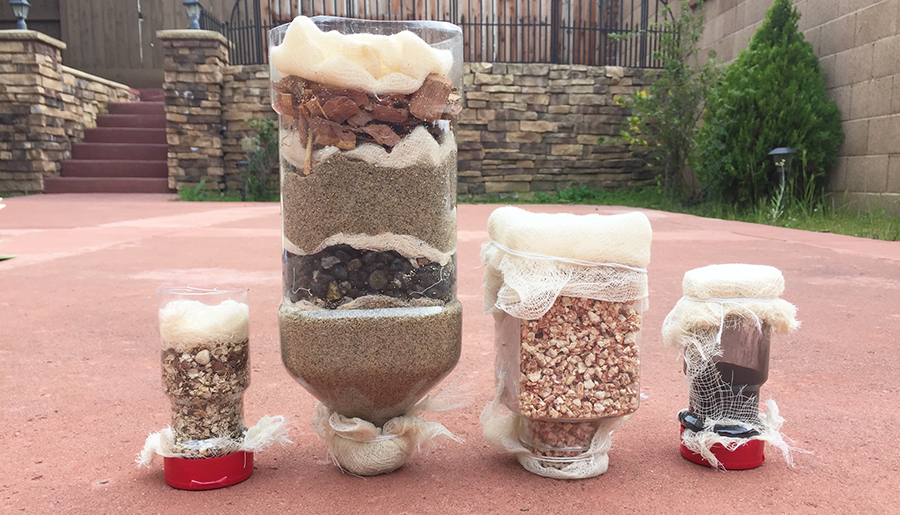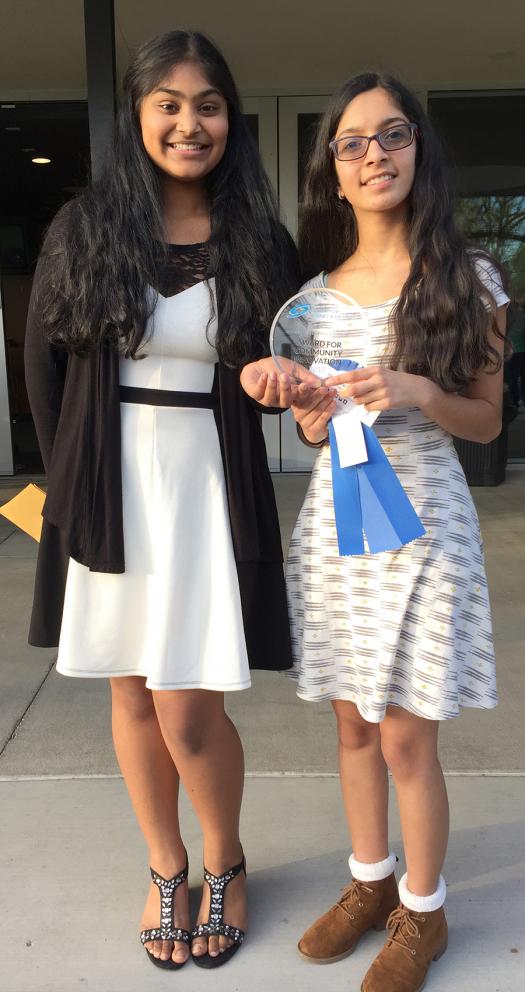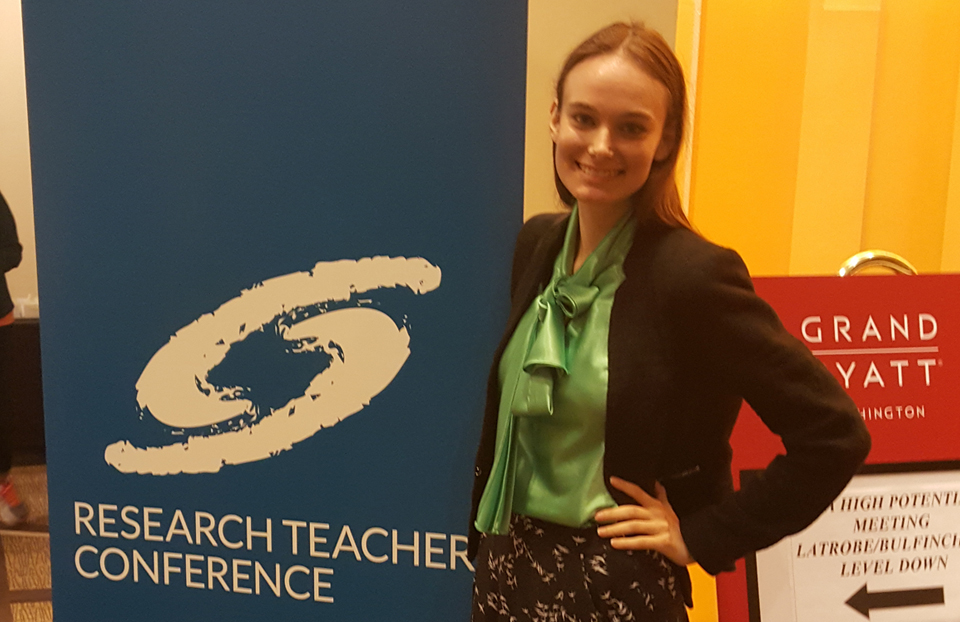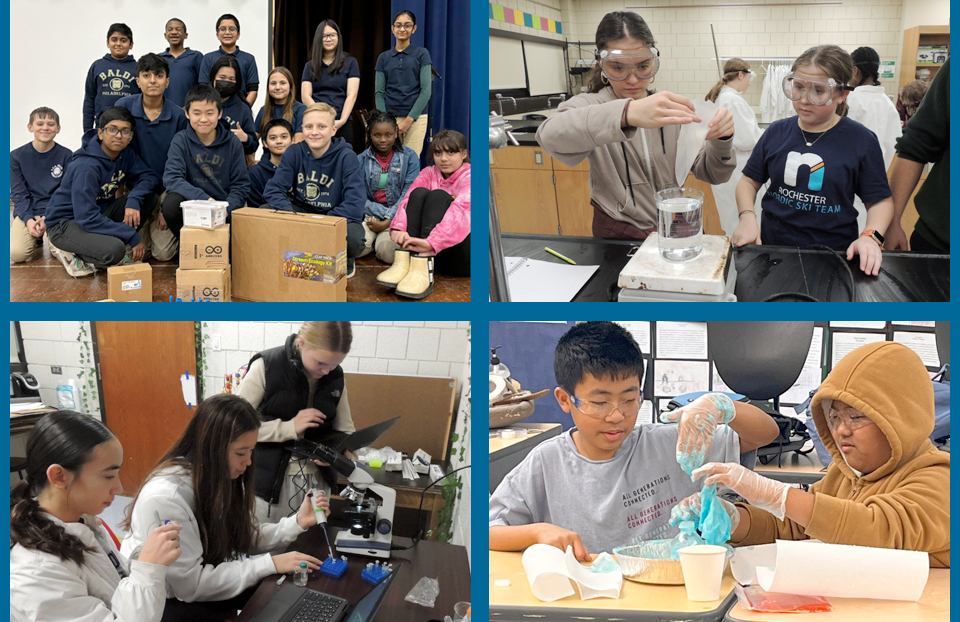Natural materials successfully filter greywater

Akshara Legala and Suditi Bhatt, two high school students from Sacramento, California, developed and tested greywater filtration systems with natural filters. Greywater is a way to recycle used water, and a method environmentalists tout to save freshwater resources for drinking while greywater could be used for appliances and agriculture.
Nurturing the next generation of scientists — like these young women — is one of our main goals at the Society for Science & the Public. To help us reach this goal, the Society recognized 20 students competing in science fairs throughout the country to recognize their STEM efforts. These Community Innovation Awards, part of the Society’s STEM Action Grants, recognize amazing young scientists.
Read on below to learn how their device works and how they first became interested in science.

HOW THEIR GREYWATER FILTRATION METHOD WORKS: Only three percent of the water on Earth is freshwater that can be consumed by living creatures. According to the EPA, an average American home annually uses 21,900 gallons of freshwater to irrigate lawns and gardens, while 102,200 gallons of freshwater a year are used for household appliances. Eighty percent of America’s water supply is used to irrigate agricultural crops.
Natural fibrous components — like activated charcoal powder, moringa oleifera seeds, and crushed corn cob — have the potential to purify greywater.
Greywater treatment is a method to reuse used water and save freshwater resources for drinking purposes. Greywater is water that has been used in household appliances or drained out as sprinkler water. Although greywater isn’t fit for human consumption, it’s a potential resource for agriculture. Greywater treatment is also less expensive than water desalination.
Greywater removes large contaminants from water, like hair, dirt, and grass. One obstacle with standard filters is they are unable to refine excess salts, chemicals, and minerals that may pollute the water. Chlorine and disinfecting additives can be added to the water; however, it would be ideal to minimize the addition of artificial chemicals in greywater treatment for agricultural use.
Greywater treatment is a method to reuse used water and save freshwater resources for drinking purposes.
In Latin America and Africa, natural filters are used in greywater filtration systems. We researched whether fibers like coconut husks, maize, and seeds remove chemical toxins from water, and if they could filter polluted freshwater the same as greywater. Through research, we found natural fibrous components with the potential to purify greywater: activated charcoal powder, moringa oleifera seeds, and crushed corn cob. Charcoal powder has been used in greywater treatments before, and it can replace chlorine as a natural disinfectant; the seeds contain a protein with an antimicrobial effect in water filtration; and the corn has the ability to trap chemicals in its pores and soak in excess salts like calcium and magnesium.
In Latin America and Africa, natural filters are used in greywater filtration systems.
First, we constructed a standard filter that would remove large contaminants from greywater. In a 2-liter plastic bottle, a quarter was filled with moist sand, which is effective at absorbing bacteria and dirt. The middle layer contained pebbles that capture large particles. The top layer contained moist wood chips, which has properties that contribute to the removal of oils and grease from the water. Cheesecloth was positioned between each layer to keep the contents in the filter organized. Then, 12 cups of greywater (pH of 7.7) was poured into the filter. Four cups of this water was placed into three separate containers with charcoal, seeds, and corn cob. We left the fibers to soak in greywater for at least 48 hours; and the treated water was then run through a sand filter. We then analyzed the filtered greywater for pH, chlorine, nitrate, nitrite, iron, hardness, and copper levels.
Only three percent of the water on Earth is freshwater that can be consumed by living creatures.
All three natural additives were successful in refining certain properties of greywater. The water filtered with corn cob filtered chlorine, nitrates, and concentrations of calcium and magnesium; however, the amount of iron that remained (0.3 ppm) is harmful for drinking and irrigation. If the iron level is over 0.1 ppm, it can cause discoloration in plants and may be toxic to plant tissue. The desired pH for agricultural irrigation ranges between 5.0-7.0.The water filtered with the seeds reduced chlorine, copper, nitrate, and iron levels to 0 ppm, the pH became more acidic, and the hardness increased from 100 ppm to 250 ppm. Although this concentration of minerals isn’t ideal for drinking, the richness is beneficial for the health of agricultural crops (as long as it isn’t over 250 ppm). The water filtered with charcoal produced similar results to the seeds: all tested chemical properties were 0 ppm, the pH became 5.0, and the hardness increased to 250 ppm.
Activated charcoal worked best to filter the greywater, but the seeds have the potential to successfully filter water for agriculture.
WHAT THE COMMUNITY INNOVATION AWARD MEANS TO THEM: This recognition is an honor to receive and it really motivates us to continue our research about STEM topics. The award is a reward that encourages us to keep learning about new ideas and working hard.
HOW THEY FIRST BECAME INTERESTED IN STEM:
I wanted to learn more about technology and the impact it has on society … [so] I joined a Lego robotics team.
Akshara: I was first interested in STEM in fourth grade. I wanted to learn more about technology and the impact it has on society. To learn more, I joined a Lego robotics team. This experience furthered my passion for STEM and it allowed me to use critical thinking skills to develop solutions to problems in our community. Another reason I was interested in STEM is because of my parents’ occupations. Both my parents are software engineers who have encouraged me to participate in STEM related programs. Their background has motivated me into learning more about science and technology.
My interest in STEM developed when I visited a facility for the blind in India … the computers were designed to have Braille keyboards and voice-activated functions.
Suditi: My interest in the STEM field developed when I visited a facility for the blind in India. At the facility, the computers and devices were designed to all have Braille keyboards and voice-activated functions. Many of the children shared with me how these technologies allowed them to access the Internet for educational purposes, overcome the challenges of their visual disabilities, and reach their full potential. This experience led me to appreciate the positive impact scientific advances and technology have had on society. By personally witnessing the ways technology can be applied to improve lives, my trip to the blind association really inspired my interest in STEM.
ON THE IMPORTANCE OF SCIENCE FAIRS: Science fairs are important because they encourage students to apply their skills to a STEM topic and share their ideas and research. Not only do students learn how to perform research for projects and conduct experiments through science fairs, they also gain motivation to expose themselves to various topics and opportunities in the STEM field.
THEIR CURRENT STEM GOALS:
Akshara: My current STEM goal is to continue learning more about the different fields in STEM and to implement my learning to help the community. I also want to pursue a career as a doctor and improve medical technologies in the future.
Suditi: My STEM goal is to continue to research topics and expose myself to situations where I can understand how science and technology can be used to improve the lives of others.
Make sure to follow your passion and always have fun doing it!
AKSHARA’S ADVICE TO OTHERS INTERESTED IN STEM: Make sure to follow your passion and always have fun doing it! Stay curious and open-minded about the ideas you learn about.Read about more Community Innovation Award Winners Admin Title: cta


